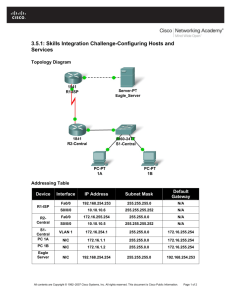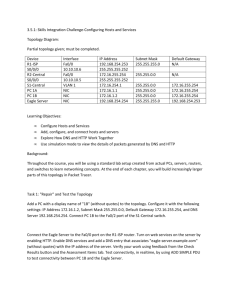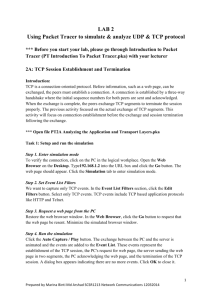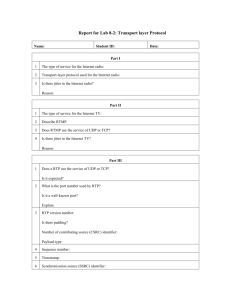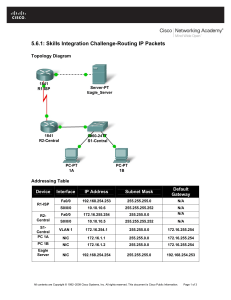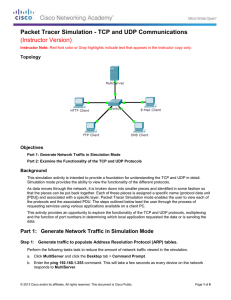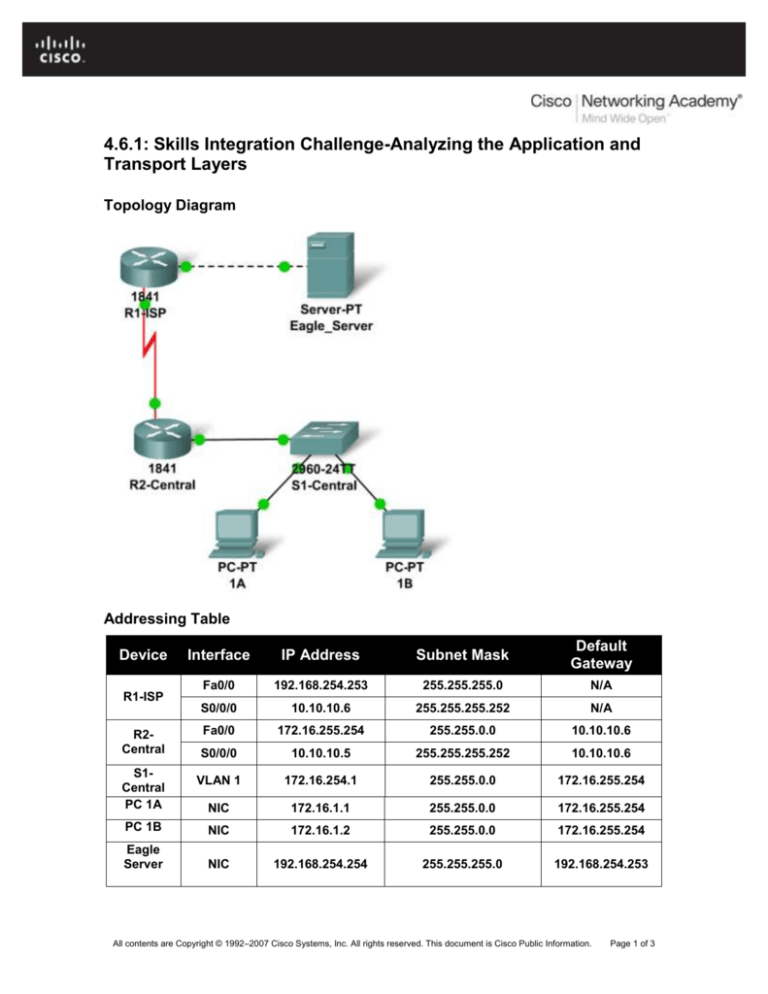
4.6.1: Skills Integration Challenge-Analyzing the Application and
Transport Layers
Topology Diagram
Addressing Table
Interface
IP Address
Subnet Mask
Default
Gateway
Fa0/0
192.168.254.253
255.255.255.0
N/A
S0/0/0
10.10.10.6
255.255.255.252
N/A
Fa0/0
172.16.255.254
255.255.0.0
10.10.10.6
S0/0/0
10.10.10.5
255.255.255.252
10.10.10.6
VLAN 1
172.16.254.1
255.255.0.0
172.16.255.254
NIC
172.16.1.1
255.255.0.0
172.16.255.254
PC 1B
NIC
172.16.1.2
255.255.0.0
172.16.255.254
Eagle
Server
NIC
192.168.254.254
255.255.255.0
192.168.254.253
Device
R1-ISP
R2Central
S1Central
PC 1A
All contents are Copyright © 1992–2007 Cisco Systems, Inc. All rights reserved. This document is Cisco Public Information.
Page 1 of 3
CCNA Exploration
Network Fundamentals:
OSI Transport Layer
4.6.1: Skills Integration Challenge-Analyzing the Application and Transport Layers
Learning Objectives
Configure Hosts and Services
Connect and configure hosts and services on the model of the lab network
Explore How DNS, UDP, HTTP, and UDP Work Together
Use simulation mode to visualize the operation of DNS, UDP, HTTP, and TCP on the
model of the lab network.
Background
Throughout the course you will be using a standard lab setup created from actual PCs, servers,
routers, and switches to learn networking concepts. At the end of each chapter, you will build
increasingly larger parts of this topology in Packet Tracer, and analyze increasingly more
complex protocol interactions.
Task 1: Repair and Test the Topology.
The server has been replaced. It must be powered on. Then configure it with the following
settings: IP Address 192.168.254.254, Subnet Mask 255.255.255.0, Default Gateway
192.168.254.253, DNS enabled, with the association of eagle-server.example.com with the
server's IP address, HTTP enabled. Connect the Eagle Server to the Fa0/0 port on the R1-ISP
router using a crossover cable.
PC 1A has lost its IP address information. Configure it with the following settings: IP Address
172.16.1.1, Subnet Mask 255.255.0.0, Default Gateway 172.16.255.254, and DNS Server
192.168.254.254. Connect PC 1A to the Fa0/1 port of the S1-Central switch using a straightthrough cable.
Verify your work using feedback from the Check Results button and the Assessment Items tab.
Test connectivity, in realtime, by using ADD SIMPLE PDU to test connectivity between PC 1A
and the Eagle Server.
Note that when you add a simple PDU, it appears in the PDU List Window as part of "Scenario 0".
The first time you issue this one-shot ping message, it will show as Failed--this is because of the
ARP process which will be explained later. Double clicking the "Fire" button in the PDU List
Window, send this single test ping a second time. This time it will be successful. In Packet Tracer,
the term "scenario" means a specific configuration of one or more test packets. You can create
different test packet scenarios by using the New button--for example Scenario 0 might have one
test packet from PC 1A to Eagle Server; Scenario 1 might have test packets between PC 1B and
the routers; and so on. You can remove all test packets in a particular scenario by using the
Delete button. For example, if you use the Delete button for Scenario 0 the test packet you just
created between PC 1A and Eagle Server will be removed--please do this prior to the next task.
Task 2: Explore How DNS, UDP, HTTP, and TCP Work Together
Switch from Realtime to Simulation Mode. Make sure Event Filter is set to display DNS, UDP,
HTTP, TCP, and ICMP. Open a web browser from the desktop of 1A. Type in the URL eagleserver.example.com, press Enter, and then use the Capture / Forward button in the Event List
to capture the interaction of DNS, UDP, HTTP and TCP.
All contents are Copyright © 1992–2007 Cisco Systems, Inc. All rights reserved. This document is Cisco Public Information.
Page 2 of 3
CCNA Exploration
Network Fundamentals:
OSI Transport Layer
4.6.1: Skills Integration Challenge-Analyzing the Application and Transport Layers
You can examine the packet in two ways: by clicking on the packet envelope as it is displayed in
the animation, or by clicking on the Info column for that packet instance as it is listed in the Event
List. Play this animation and examine the Packet contents (PDU Information Window, Inbound
PDU Details, Outbound PDU Details) for each event in the event list, especially when the
packets are at PC 1A or at the Eagle Server. If you receive a "Buffer Full" message, click the
View Previous Events button. While the processing of the packets at the switch and the routers
may not make sense to you yet, you should be able to see how DNS, UDP, HTTP, and TCP work
together by studying tracing the packets and using the PDU Information window to look "inside"
them.
Reflection
Can you make a diagram of the sequence of protocol events involved in requesting a web page
using a URL? Where might things go wrong? Compare and contrast DNS and HTTP, and UDP
and TCP.
All contents are Copyright © 1992–2007 Cisco Systems, Inc. All rights reserved. This document is Cisco Public Information.
Page 3 of 3

